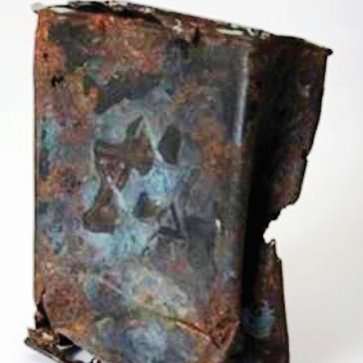click to dowload our latest edition
CLICK HERE TO SUBSCRIBE TO OUR NEWSLETTER


Published
5 years agoon
By
adminDAVID SAKS
Amidst the bustle of daily life, frequently in lands where Jews suffered under harshly oppressive conditions, people made sure to drop the occasional coin into their JNF pushka (container for collecting money). This enabled them to participate in a practical, meaningful way in rebuilding and resettling Israel.
The practice of offering money to connect to the greater Jewish community and to Israel has Biblical origins in the practice of machatsit hashekel, the annual half-shekel donation given by Jews living outside of Jerusalem to support the Temple.
The practice of issuing collection boxes to support the work of the Keren Kayemet L’Yisrael (KKL – “the sustaining fund of Israel”, as the JNF is called in Israel) gradually stopped – although it was never formally discontinued by the JNF – so that today, few of the younger generation have ever heard of it, according to Bev Price, the education officer at JNF-SA.
“The Blue Box was something that cut across differences in religious practice and ideological differences, and came to embody the single-minded commitment of diaspora Jewry to Israel”, Price said. “JNF-SA is embarking on an awareness programme to engender enthusiasm for the Blue Box. We are contextualising the relevance of the Blue Box in our own century, and as far as possible, aiming to get one into every Jewish home once again.”
Another aim of the initiative is to pay tribute to members of the older generation who established the Jewish community and devoted themselves to raising funds for the yishuv (Jewish residents in the land of Israel prior to Israel’s establishment) and thereafter for the state of Israel.
The person generally credited with inventing the Blue Box (although there are other claimants in that regard) is Haim Kleinman, a bank clerk from Galicia. Shortly after the establishment of the KKL at the 5th Zionist Congress in December 1901, he decided to place a collection box for it in his office. He was sufficiently impressed by the enthusiastic response to write the following in a letter to Die Welt, the Zionist newspaper in Vienna:
“In keeping with the saying, ‘bit and bitty fill the kitty’, and following the congress resolution on KKL’s founding, I put together an ‘Erez Israel box’, stuck the words ‘National Fund’ on it, and placed it in a prominent spot in my office. The results, given the extent of the experiment so far, have been astonishing. I suggest that like-minded people, and particularly all Zionist officials, collect contributions to KKL in this way.”
The rest, as they say, is history. Before long, KKL pushkes were appearing everywhere, whether in the shtetls (small Jewish towns) of Eastern Europe, the larger cities of Western Europe and the new world, or isolated dorps (towns) in the rough-and-ready hinterland of South Africa.
It provided a steady stream of revenue to assist the KKL in realising its aim of developing the land of Israel, laying down the original pre-state infrastructure including planting forests, building roads and water reservoirs, establishing parks, and preparing the soil for agriculture and settlement.
The initiative went beyond simple fundraising. From the outset, it also functioned as an educational tool through which to spread the Zionist message and renew the historic bond between the Jewish people and eretz Yisrael. The official “Blue Box”, with its distinctive colour and design, was introduced as early as 1904.
There is, inevitably, a tragic side to the Blue Box saga. Originally, they were found primarily in Central and Eastern European countries, including Russia. With the double catastrophe of communism followed not long afterwards by Nazism, they all but disappeared from these areas and instead, moved to Anglo-Saxon countries and Latin America.
One of the most affecting relics of the Holocaust is a rusted, battered Blue Box recovered from the ruins of the Warsaw Ghetto. On the one hand, it testifies to the unspeakable tragedy that engulfed the Jews of Europe during that time, yet there is another, more uplifting, meaning one could read into it. In the words of KKL-JNF Chairman Efi Stenzler (Jerusalem Post, 15 April 2015), it shows how even in the desperate circumstances in which they found themselves, “the ghetto fighters drew hope of saving themselves from the inferno and arriving in the land of Israel”.
Price says that in the 21st century, KKL-JNF has evolved into the “elder custodian” of the land, keeping it well-manicured, as well as implementing many civic projects for Israelis (particularly those in vulnerable parts of the country like the Gaza envelope).
“The continuous presence of the Blue Box over the past 114 years has served as a symbolic object in Jewish homes and a visual reminder to Jews living in the diaspora that our geographic location does not preclude our commitment to and love for our spiritual homeland.
“On the contrary, JNF South Africa hopes to restore the humble ritual of placing money in a Blue Box for Israel (before lighting candles on Friday night, for example) as well as the tradition of contacting the JNF-SA ‘Blue Box lady’ once your box is full. Just as our parents and grandparents did,” she said.

Rita Hillel
Jun 17, 2019 at 12:03 pm
‘Just read this article. I live in Yael Street in the Baka neighborhood in Jerusalem. I once did a tour of my neighborhood with Yad Ben Zvi organization and learned that the Blue Box factory was on the corner of what is Yael and Yiftah Street today. Today there is a neighborhood park on the corner. ‘
Beverley Price
Jul 8, 2019 at 8:13 am
‘Hello Rita
My goodness, I currently live in Johannesburg and work at the JNF….I am the Blue Box lady these days.
I used to live on Gidon until 1995 for 10 years, around the corner from where you are describing in Baka! crazy stuff. I know the park!
משהו!!’